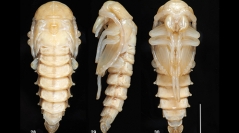

 European Journal of Taxonomy
2020 (640) - Pages 1-22
European Journal of Taxonomy
2020 (640) - Pages 1-22Detailed description and illustrations of immature Trictenotoma Gray, 1832 (Trictenotomidae Blanchard, 1845) are presented for the first time, based on larvae and pupae of T. formosana Kriesche, 1919. Characters exhibited by the mature larva are similar to those described by Gahan (1908) for T. childreni Gray, 1832, which was based on a single specimen. The phylogenetic position of Trictenotomidae has varied among Scarabaeoidea, Chrysomeloidea and Tenebrionoidea, though recent studies place the family clearly among the latter. Features of the immature stages described here corroborate this placement. Evidence supports placement within or near the “salpingid group” (Pythidae, Salpingidae, Boridae, Pyrochroidae). Distinguishing features of the mature trictenotomid larva include the absence of stemmata, antennal sensorium, urogomphal pit(s) and lip, the presence of paired series of longitudinal ridges on the meso- and metathorax and abdominal tergites 1–8 and sternites 2–8, a paired arcuate row of 12–15 asperities on the anterior margin of sternite 9 and relatively short, upturned urogomphi. The systematic position of trictenotomids within the Tenebrionoidea Latreille, 1802 is confirmed. The phylogenetic relationships among Trictenotomidae and other “salpingid group” members (e.g., Pythidae Solier, 1834 and Salpingidae Leach, 1815) are highlighted and discussed, solving an almost two centuries old puzzle in Coleoptera systematics.